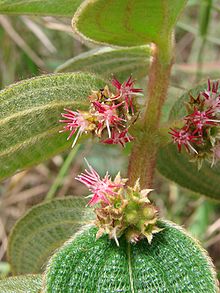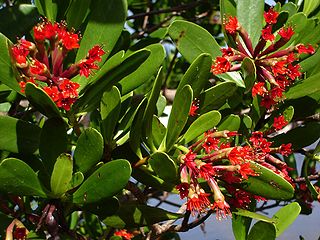
The Myrtales are an order of flowering plants placed as a sister to the eurosids II clade as of the publishing of the Eucalyptus grandis genome in June 2014.

Melastomataceae is a family of dicotyledonous flowering plants found mostly in the tropics comprising c. 165 genera and c. 5115 known species. Melastomes are annual or perennial herbs, shrubs, or small trees.

Tibouchina Aubl. is a neotropical flowering plant genus in Melastomataceae Juss. that contains approximately 240 species. Species of this genus are herbs, shrubs or trees and typically have purple flowers. They are native to Mexico, the Caribbean, and South America where they are found as far south as northern Argentina. Members of this genus are known as glory bushes, glory trees or princess flowers. The name Tibouchina is adapted from a Guianan indigenous name for a member of this genus [2]. A recent systematic study has shown that this genus is paraphyletic.
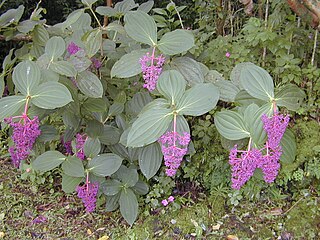
Medinilla is a genus of about 400 species of flowering plants in the family Melastomataceae, native to tropical regions of the Old World from Africa east through Madagascar and southern Asia to the western Pacific Ocean islands. The genus was named after J. de Medinilla, governor of the Mariana Islands in 1820.

Miconia is a genus of flowering plants in the glory bush family, Melastomataceae, native to warm temperate to tropical regions of the Americas. The species are mostly shrubs and small to medium-sized trees up to 15 m tall. The generic name honours Catalan physician and botanist Francesc Micó. Some species are known by the common name johnnyberry.

Melastoma affine, also known by the common names blue tongue or native lassiandra, is a shrub of the family Melastomataceae. Distributed in tropical and sub-tropical forests of India, South-east Asia and Australia, it is a plant of rainforest margins. Bees are the principal pollinators of this species.
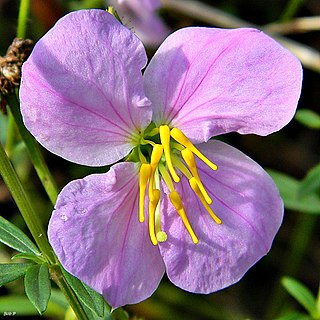
Rhexia is a genus of flowering plants in the family Melastomataceae. Rhexia species are commonly called "meadow beauty" and 11 to 13 species of Rhexia have been recognized depending on different taxonomic treatments.
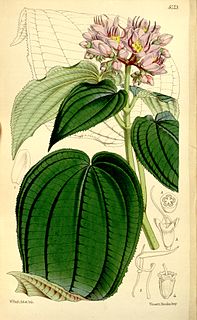
Amphiblemma is a genus of flowering plants in the family Melastomataceae. There are at least 15 species distributed in the evergreen forests of Africa.

Axinaea is a genus of flowering plants in the family Melastomataceae. As of 2012, there are at least 42 species. They are small trees and shrubs. They are native to the Americas; almost all are found in the Andes.
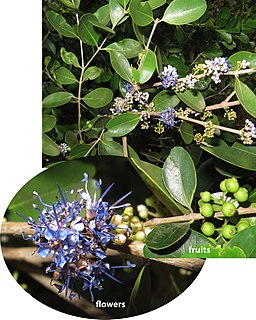
Memecylon is a plant group in Melastomataceae. It consists of 350-400 species of small to medium-sized trees and shrubs occurring in the Old World tropics. Memecylon is a monophyletic group basal to the Melastomataceae clade. Memecylon taxa have more than 600 published basionyms. Diversity of this group is concentrated in tropical Africa, Madagascar, Sri Lanka, India and Malaysia.

Meriania is a genus of flowering plants in the family Melastomataceae. There are about 93 species distributed from Mexico to Brazil and the Antilles.
Ossaea boekei is a species of plant in the family Melastomataceae. It is endemic to Ecuador.
Ossaea incerta is a species of plant in the family Melastomataceae. It is endemic to Ecuador.
Ossaea palenquensis is a species of plant in the family Melastomataceae. It is endemic to Ecuador.
Ossaea sparrei is a species of plant in the family Melastomataceae. It is endemic to Ecuador.
Tessmannianthus is a genus of flowering plants in the family Melastomataceae. There are seven species distributed in Central and South America. They are medium to large trees up to 40 meters tall. The flowers are heterantherous, bearing two types of stamens. These plants are rare, and some are narrow endemics known from only one location.
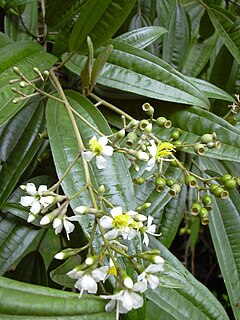
Tetrazygia is a genus of flowering plants in the family Melastomataceae. They are native to the Antilles, and one species also occurs in Florida in the United States. The circumscription of the genus has been debated, but in general, about 25 species are accepted. Clover ash is a common name for plants in this genus.

Bertolonia is a genus consisting of 14 species of pretty, dwarf, creeping, tender perennials, native to tropical South America. These herbaceous plants are grown for their colorful, velvety, ornamental foliages, vary from shimmery white with purple, pink with purple, or bronze-green with carmine and lighter midribs, purple beneath. Leaves are coarsely hairy, oval 7 cm (3 in) long on short stalks. The plants bear clusters of small, bell-shaped flowers repeatedly, just above the leaves, color ranges from pink, red, yellow to purple.
Calycogonium is a polyphyletic genus of about forty species in the family Melastomataceae, native to the Caribbean, particularly Hispaniola, Jamaica, and Cuba. The genus is a member of a clade characterized by calyptra on flower buds, few hairs, and the presence of mite domatia on the underside of the leaves.
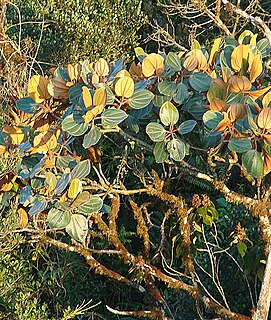
Graffenrieda is a genus of flowering plants in the family Melastomataceae. There are about 44 species. Most occur in South America. A few are distributed in Mexico, Central America and the Caribbean.
